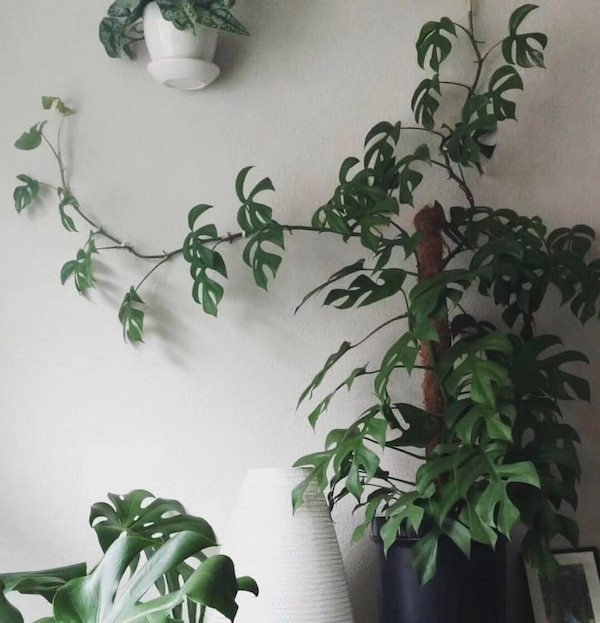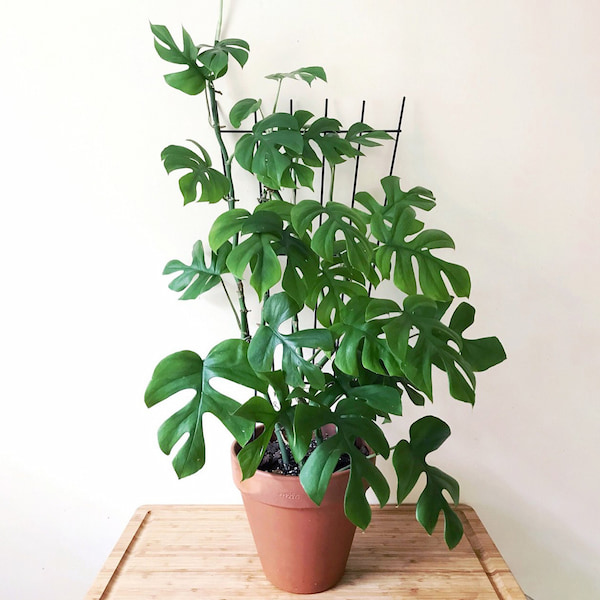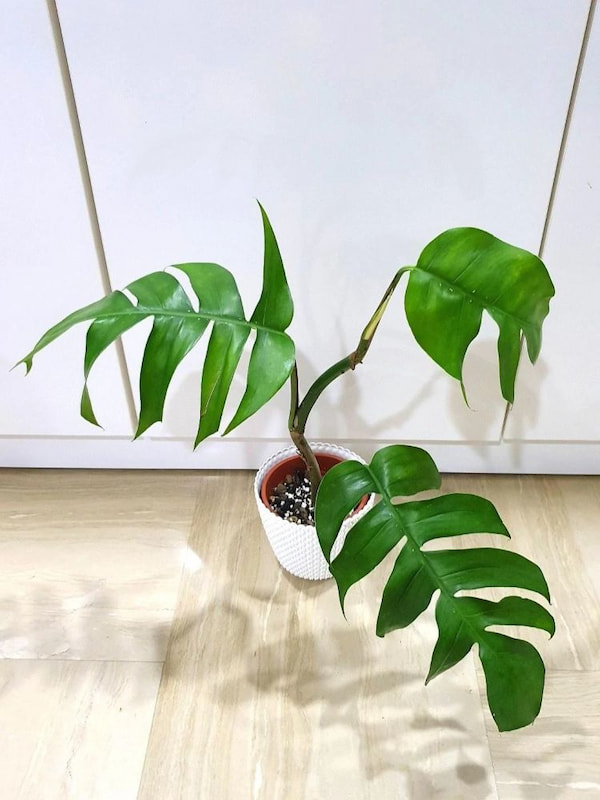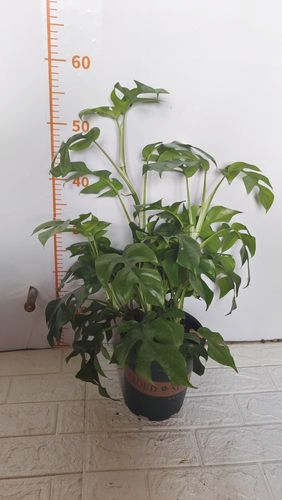Rhaphidophora Tetrasperma Care & Propagation
Written by Lisa
Dec 28 2021

Rhaphidophora tetrasperma is a tropical plant suitable for indoor plants with small dehiscent green leaves. For a long time before it was widely introduced as a horticultural plant, it was found only in peninsular Malaysia and a few places in southern Thailand.

Rhaphidophora Tetrasperma is usually kept in the shade of a tree, and potted on an east-facing windowsill indoors without excessive shade.
As a green plant, Rhaphidophora Tetrasperma needs proper light to grow. Because it is not resistant to strong light exposure, so must do shading work in the summer. In spring and autumn at noon also do not place Rhaphidophora Tetrasperma directly under the sun. If the environment is too dark, it will not be good for Rhaphidophora Tetrasperma growth, so be sure to keep it indoors in a bright place.
When potted, the Rhaphidophora Tetrasperma leaves cannot split if the plant is not mature enough or if the light is not enough.
Read More:
How Much Light Does Rhaphidophora Tetrasperma Need
Potted Rhaphidophora Tetrasperma plants are safe to overwinter at a minimum temperature of 10 degrees Celsius (suitable 18 to 28 degrees Celsius). In summer, when the temperature exceeds 35 degrees, pay attention to cooling and ventilation, and appropriate shade. Excessive and intense light will sunburn the leaves. Rhaphidophora Tetrasperma also shows reduced growth in high temperatures.
Rhaphidophora Tetrasperma does not require high humidity in the air. It can adapt to low ambient humidity, but it is best to keep indoor relative humidity above 35%. If the air is too dry, it can also lead to leaf tip drying.
Increase photosynthesis by occasionally cleaning the leaves of the Rhaphidophora Tetrasperma and occasionally spraying them with water mist to increase humidity and promote photosynthesis. Of course, in winter when the temperature is low, do not spray the leaves.
In the growth Rhaphidophora Tetrasperma demand for a lot of water, so it should be timely water, generally watering every day. In summer watering can be frequent, which can be in the morning and evening watering. If the climate is dry, you needs regular spraying water to watering, which can not only wash the leaf surface, but also improve the humidity.
Read More:
How To Water Rhaphidophora Tetrasperma?
Where to prune: Make a 45-degree diagonal cut about 1 cm below the branches. Its habits and reproduction methods are similar.
Cuttings can be simply propagated by putting the cuttings in water for hydroponics, or by sticking them in moist soil.
2. Scale insects: they can harm the leaves and petioles of Rhaphidophora Tetrasperma plants. Brush them directly when a small amount is needed, and spray them with dimethoate when a large amount is needed.
Whenever a rhaphidophora tetrasperma cutting branch has a growth node, air roots will grow at the node, and if the branch is immersed in clear water, white roots will develop after a few days.
When propagating Rhaphidophora Tetrasperma in water, cuttings can be placed in the ventilated window sill side, to a little soft scattering light, keep a warm environment (temperature between 20~25 degrees), every two or three days to change the water once, about a week or so, the root system can grow longer.
Brown aerial roots grow on the stems of Rhaphidophora Tetrasperma, and their main function is to hold things in place while they cling to things. Its stems grow very thick and woody over time.
1. Unsuitable Soil
Rhaphidophora Tetrasperma prefers to grow in moist, slightly acidic, fertile soil. If the soil is too alkaline, rigid, or sticky, it will cause poor air permeability and poor drainage of roots, resulting in water accumulation and yellow leaves.
So we can grow Rhaphidophora Tetrasperma in saprophytic soil or peat soil, as long as the soil is slightly acidic and permeable to the air, so that the pots don't accumulate water and the leaves of Rhaphidophora Tetrasperma turn yellow. Rhaphidophora Tetrasperma grows even more exuberant.
2. Not Watering Properly
Rhaphidophora Tetrasperma prefers to grow in slightly moist soil. Yellow leaves can also occur if the soil is too dry for a long time or if water is too frequent.
Therefore, we need to water regularly. We water the soil by observing how dry and wet it is. When we see that the surface of the soil is dry and white, we can water it.
3. Improper lighting
Rhaphidophora Tetrasperma is light tolerant and shade tolerant. The leaves will turn yellow due to insufficient photosynthesis due to lack of light. Conversely, if summer sun exposure will also cause leaf burns and yellow.
Therefore, Rhaphidophora Tetrasperma can grow in a well-lit place. Do not let it be in a dark place for a long time. In summer, we need semi-shade maintenance and try to avoid direct sunlight. In winter and spring, when the light is weak, we can put Rhaphidophora Tetrasperma in the open air. When the weather is fine, pay attention to the shade when the light is strong. Of course, Rhaphidophora Tetrasperma can grow well just by keeping it in bright light.
4. Low Temperature
The optimum growth temperature of Rhaphidophora Tetrasperma is 18-28 ℃. When the temperature is lower than 5℃ in winter, the growth of Rhaphidophora Tetrasperma will enter a state of stagnation. The lower the temperature is, the more likely it is to suffer from freezing injury and the leaves will turn yellow. Rhaphidophora Tetrasperma should be protected from the cold during the winter.
(Read More about Rhaphidophora Tetrasperma brown spots.)
However, it should be noted that watering depends on temperature. In winter, if the room temperature is below 15 degrees, watering frequency should be reduced, otherwise the roots will be frozen rotten. In summer and autumn, in addition to watering, spray water around the leaves to improve the air humidity of the small environment.
If you notice that the leaves of Rhaphidophora Tetrasperma are curled up and dry at their tips, it's usually due to too much dry air, or too much fertilizer.
Rhaphidophora Tetrasperma Basic Info Rhaphidophora Tetrasperma CareRhaphidophora Tetrasperma Soil CareRhaphidophora Tetrasperma Light RequirementRhaphidophora Tetrasperma Temperature & Humidity CareRhaphidophora Tetrasperma WateringRhaphidophora Tetrasperma FertilizerRhaphidophora Tetrasperma PruningRhaphidophora Tetrasperma Diseases & PestsRhaphidophora Tetrasperma PropagationRhaphidophora Tetrasperma Care ProblemsIs Rhaphidophora Tetrasperma Toxic To CatsRhaphidophora Tetrasperma ClimbingRhaphidophora Tetrasperma Yellow LeavesRhaphidophora Tetrasperma Brown SpotsRhaphidophora Tetrasperma Leaves Not SplittingConclusion
Rhaphidophora Tetrasperma Basic Info
| Scientific Name | Rhaphidophora tetrasperma |
| Common Name(s): | Mini monstera, monstera ‘Ginny’, philodendron ‘Ginny’ |
| Light Care | Bright indirect light, limit direct sun to prevent sunburn |
| Soil Care | Moist, but very well-draining |
| Temperture Care | 18-28 Degrees, but not lower than 10 degrees |
| Humidty Care | over 35%, suitable 60% |
| Watering | Keep soil consistently moist but not wet, as needed |
| Pests & Diseases: | Spider mites, fungal root rot |
Read More:
How To Save My Rhaphidophora Tetrasperma Root Rot?
Rhaphidophora Tetrasperma Care
Rhaphidophora Tetrasperma Soil Care
Rhaphidophora tetrasperma is usually grown in soft soil, where good drainage is important for plant growth and respiration. Garden soil, sand and barnyard manure are usually mixed to prepare culture soil in a ratio of 2:2:1. The rhaphidophora tetrasperma is usually repotted every two years to prevent the soil from hardening and affecting water infiltration. (Read more about Rhaphidophora Tetrasperma soil.)
Rhaphidophora Tetrasperma Light Requirement
Rhaphidophora Tetrasperma, which grows in tropical woodlands, is afraid of bright light and can't tolerate direct sunlight. Otherwise, the leaves of rhaphidophora Tetrasperma are prone to sunburn, characterized by brown or gray sunburn spots on the leaves.Rhaphidophora Tetrasperma is usually kept in the shade of a tree, and potted on an east-facing windowsill indoors without excessive shade.
As a green plant, Rhaphidophora Tetrasperma needs proper light to grow. Because it is not resistant to strong light exposure, so must do shading work in the summer. In spring and autumn at noon also do not place Rhaphidophora Tetrasperma directly under the sun. If the environment is too dark, it will not be good for Rhaphidophora Tetrasperma growth, so be sure to keep it indoors in a bright place.
When potted, the Rhaphidophora Tetrasperma leaves cannot split if the plant is not mature enough or if the light is not enough.
Read More:
How Much Light Does Rhaphidophora Tetrasperma Need
Rhaphidophora Tetrasperma Temperature & Humidity Care
As mentioned before, Rhaphidophora Tetrasperma grows in the rain forest, so it has a poor tolerance for cold temperatures. For some newly purchased Rhaphidophora Tetrasperma potted plants, the recommended temperature is above 10 degrees to avoid frostbite.Potted Rhaphidophora Tetrasperma plants are safe to overwinter at a minimum temperature of 10 degrees Celsius (suitable 18 to 28 degrees Celsius). In summer, when the temperature exceeds 35 degrees, pay attention to cooling and ventilation, and appropriate shade. Excessive and intense light will sunburn the leaves. Rhaphidophora Tetrasperma also shows reduced growth in high temperatures.
Rhaphidophora Tetrasperma does not require high humidity in the air. It can adapt to low ambient humidity, but it is best to keep indoor relative humidity above 35%. If the air is too dry, it can also lead to leaf tip drying.
Increase photosynthesis by occasionally cleaning the leaves of the Rhaphidophora Tetrasperma and occasionally spraying them with water mist to increase humidity and promote photosynthesis. Of course, in winter when the temperature is low, do not spray the leaves.
Rhaphidophora Tetrasperma Watering
Rhaphidophora Tetrasperma prefers wet conditions, and plants can grow poorly if they are deprived of water for a long time. Usually watering must be frequent, keep the soil moist, if the climate is relatively dry, but also to give it appropriate water, increase the humidity of the environment, and spray on the leaves, can also keep clean.In the growth Rhaphidophora Tetrasperma demand for a lot of water, so it should be timely water, generally watering every day. In summer watering can be frequent, which can be in the morning and evening watering. If the climate is dry, you needs regular spraying water to watering, which can not only wash the leaf surface, but also improve the humidity.
Read More:
How To Water Rhaphidophora Tetrasperma?
Rhaphidophora Tetrasperma Fertilizer
The growth of Rhaphidophora Tetrasperma requires certain nutrients, which are usually applied every 15-20 days during the growth period. The fertilizer is usually decomposed fertilizer water. In addition, give it a foliar fertilizer, such as potassium dihydrogen phosphate, which is sprayed every 10 days to make the leaves longer and thicker, as well as giving them luster.Rhaphidophora Tetrasperma Pruning
Rhaphidophora Tetrasperma grows relatively quickly.Where to prune: Make a 45-degree diagonal cut about 1 cm below the branches. Its habits and reproduction methods are similar.
Cuttings can be simply propagated by putting the cuttings in water for hydroponics, or by sticking them in moist soil.
Rhaphidophora Tetrasperma Diseases & Pests
1. Gray spot, leaf spot: after the onset of Rhaphidophora Tetrasperma leaves will wither, or even fall, should be used as early as possible mancozeb prevention and control. The daily maintenance environment should be ventilated and sunny.2. Scale insects: they can harm the leaves and petioles of Rhaphidophora Tetrasperma plants. Brush them directly when a small amount is needed, and spray them with dimethoate when a large amount is needed.
Rhaphidophora Tetrasperma Propagation
If you want to grow Rhaphidophora Tetrasperma potted plants, you can use cuttings, whether hydroponics or soil cuttings to propagate Rhaphidophora Tetrasperma, which are as simple as growing Pothos plants.Whenever a rhaphidophora tetrasperma cutting branch has a growth node, air roots will grow at the node, and if the branch is immersed in clear water, white roots will develop after a few days.
When propagating Rhaphidophora Tetrasperma in water, cuttings can be placed in the ventilated window sill side, to a little soft scattering light, keep a warm environment (temperature between 20~25 degrees), every two or three days to change the water once, about a week or so, the root system can grow longer.

Rhaphidophora Tetrasperma Care Problems
Is Rhaphidophora Tetrasperma Toxic To Cats
Rhaphidophora Tetrasperma is toxic to pets. Rhaphidophora Tetrasperma is best kept out of the way of pets and children as they contain calcium oxalate crystals - the plant's defence mechanism against being eaten in the wild. If the plant is digested there can be stomach pain, lethargy and a stinging sensation in the mouth.Rhaphidophora Tetrasperma Climbing
Rhaphidophora Tetrasperma has a certain climbing ability, you can set up a column in the pot, so that the stems of the Rhaphidophora Tetrasperma can climb on the column to grow. Rhaphidophora Tetrasperma is originally a vine plant, but it grows very slowly indoors in the shade, let alone climbing. In some year-round warm outdoor environments, it is common to see some Rhaphidophora Tetrasperma climbing on trees or rocks, especially in parks and botanical gardens in the south.Brown aerial roots grow on the stems of Rhaphidophora Tetrasperma, and their main function is to hold things in place while they cling to things. Its stems grow very thick and woody over time.
Rhaphidophora Tetrasperma Yellow Leaves
Here are four reasons for Rhaphidophora Tetrasperma yellow leaves1. Unsuitable Soil
Rhaphidophora Tetrasperma prefers to grow in moist, slightly acidic, fertile soil. If the soil is too alkaline, rigid, or sticky, it will cause poor air permeability and poor drainage of roots, resulting in water accumulation and yellow leaves.
So we can grow Rhaphidophora Tetrasperma in saprophytic soil or peat soil, as long as the soil is slightly acidic and permeable to the air, so that the pots don't accumulate water and the leaves of Rhaphidophora Tetrasperma turn yellow. Rhaphidophora Tetrasperma grows even more exuberant.
2. Not Watering Properly
Rhaphidophora Tetrasperma prefers to grow in slightly moist soil. Yellow leaves can also occur if the soil is too dry for a long time or if water is too frequent.
Therefore, we need to water regularly. We water the soil by observing how dry and wet it is. When we see that the surface of the soil is dry and white, we can water it.
3. Improper lighting
Rhaphidophora Tetrasperma is light tolerant and shade tolerant. The leaves will turn yellow due to insufficient photosynthesis due to lack of light. Conversely, if summer sun exposure will also cause leaf burns and yellow.
Therefore, Rhaphidophora Tetrasperma can grow in a well-lit place. Do not let it be in a dark place for a long time. In summer, we need semi-shade maintenance and try to avoid direct sunlight. In winter and spring, when the light is weak, we can put Rhaphidophora Tetrasperma in the open air. When the weather is fine, pay attention to the shade when the light is strong. Of course, Rhaphidophora Tetrasperma can grow well just by keeping it in bright light.
4. Low Temperature
The optimum growth temperature of Rhaphidophora Tetrasperma is 18-28 ℃. When the temperature is lower than 5℃ in winter, the growth of Rhaphidophora Tetrasperma will enter a state of stagnation. The lower the temperature is, the more likely it is to suffer from freezing injury and the leaves will turn yellow. Rhaphidophora Tetrasperma should be protected from the cold during the winter.
Rhaphidophora Tetrasperma Brown Spots
Rhaphidophora Tetrasperma has strong ability to adapt to the environment. If watered too much, leaf edges or petioles are easy to grow brown or black spots. Not well ventilated, lack of light, excessive moisture soil, all these reasons can be easy to cause Rhaphidophora Tetrasperma brown spots.(Read More about Rhaphidophora Tetrasperma brown spots.)
Rhaphidophora Tetrasperma Leaves Not Splitting
The following are reasons for Rhaphidophora Tetrasperma leaves not splitting.- Plant Age
- Pruning Old Leaves
- Favorable Light
- Suitable Water
However, it should be noted that watering depends on temperature. In winter, if the room temperature is below 15 degrees, watering frequency should be reduced, otherwise the roots will be frozen rotten. In summer and autumn, in addition to watering, spray water around the leaves to improve the air humidity of the small environment.
Conclusion
Rhaphidophora Tetrasperma, is a climbing plant that grows roots at its growing nodes and has a strong ability to attach itself to them. The stalk of Rhaphidophora Tetrasperma is supported with a soft cord and then allowed to climb on its own.If you notice that the leaves of Rhaphidophora Tetrasperma are curled up and dry at their tips, it's usually due to too much dry air, or too much fertilizer.
Latest Updated
- Benefits of Bugleweed - 7 Science-backed Health Benefits
- Bugleweed Dangers & Side Effects - Is It Poisonous?
- How to Plant Evergreen Trees - What You Should Know
- When to Plant Evergreens - Grow Guide for Evergreen Trees
- 12 Wonderful Evergreen Shrubs for Your Garden
- 12 Popular Evergreen Plants with Pictures for Beginners
- When And How To Prune A Lilac Bush Like a Pro
- How to Grow & Care for Lilac Vine (Hardenbergia Violacea)
- Japanese Lilac Tree (Syringa Reticulata) Care & Propagation Guide
- Shumard Oak Pros and Cons - What to Know
Popular Articles
- Winter maintenance of Antirrhinum Majus
- How to Grow Terminalia Mantaly Tree
- How to Grow and Care for Crossostephium Chinense
- How to grow Antirrhinum Majus in spring
- Peristeria Elata (Dove Orchid) Profile: Info & Care Guide
- Underwatered Snake Plant (Sansevieria Trifasciata) - Signs And How To Fix
- How to Care for Brazilian Jasmine Plant (Mandevilla Sanderi)
- How to Grow & Care for Graptopetalum Purple Delight in Summer
- Rosa Chinensis (China Rose): Plant Growing & Care Tips
- How to Care for Baby Sun Rose (Aptenia Cordifolia)
